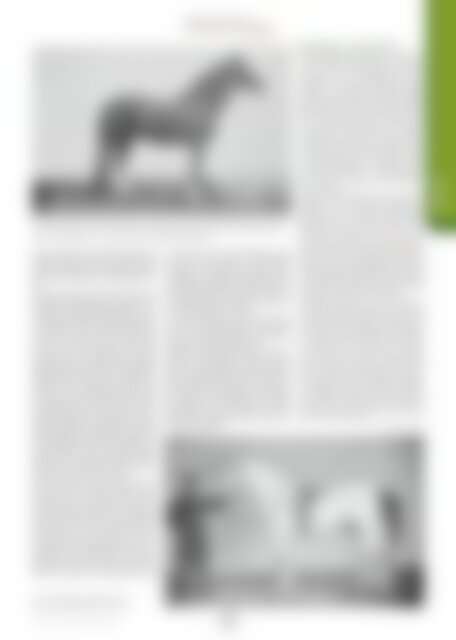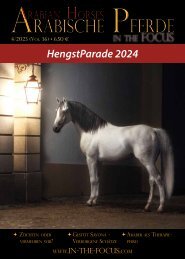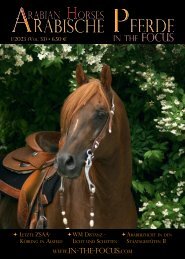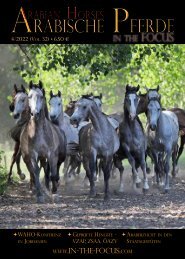Arabische Pferde IN THE FOCUS Nr. 3-2020 (Vol. 23) - public
Zeitschrift für Liebhaber und Züchter arabischer Pferde
Zeitschrift für Liebhaber und Züchter arabischer Pferde
Erfolgreiche ePaper selbst erstellen
Machen Sie aus Ihren PDF Publikationen ein blätterbares Flipbook mit unserer einzigartigen Google optimierten e-Paper Software.
The stallion Sultan, a desertbred imported 1895 to Antoniny, born in Iraq where he was a good<br />
racehorse in Bagdad. - Der Hengst Sultan, ein Original-Araber importiert 1895 für Antoniny. Er<br />
wurde im Irak geboren, wo er ein gutes Rennpferd in Bagdad war.<br />
been turned over to Józef in 1880, a fact of which<br />
Lady Anne approves in her diary. Reunited with<br />
Pharaoh, she noted that “[h]e knew me again<br />
when I spoke, though I was not offering him sugar”.<br />
Lady Anne liked the horses she saw at Antoniny,<br />
though she was disappointed to learn that “several<br />
of them have a flaw in their pedigree, a cross<br />
of English”, and regretfully observed that “now it<br />
is very difficult to find one quite pure”, adding "I<br />
should very much like to have something from<br />
this stud if we could find a pure one for sale”.<br />
Forty years later, her daughter Judith would<br />
find Skowronek, and purchase him for Crabbet,<br />
paying no mind to the flaws in the pedigree that<br />
had bothered her mother. However, in 1895, Wilfrid<br />
Blunt made a second trip to Antoniny, and<br />
found the stud in “a deplorable condition, about<br />
a dozen good mares left, mostly old ones, and all<br />
the younger generation inferior, of the kind we<br />
would draft away”. As for the Branicki stud, he<br />
wrote that “Branicki has abandoned pure Arab<br />
breeding through lack of stallions, and the English<br />
Thoroughbred is invading everything”. Ironically,<br />
thirty years before, in 1864, the Branicki<br />
Arabians had such a good reputation that the<br />
Ottoman sultan Abdulaziz had imported some<br />
of their horses for use in his own stud.<br />
On the other hand, during the 1895 trip, Wilfrid<br />
also visited the main Sanguszko stud at<br />
Chrestówka, now managed by Prince Roman<br />
Damian Sanguszko, also known as Roman the<br />
Younger, and was very taken with the quality of<br />
the horses there: “it really is very fine, better than<br />
the Antonin one was 11 years ago”. He wrote to<br />
Judith that there were fully forty mares at Chrestówka<br />
that he would have liked to purchase,<br />
particularly some fleabitten greys, “with more<br />
flea-bites than grey”. He further advised Józef<br />
Potocki to sell most of the Antoniny stock and<br />
replace it with mares from Chrestówka, as well<br />
as to find two new stallions. In 1899, Potocki<br />
succeeded in importing a desertbred stallion<br />
Hamdanie and a Kuhaylat al-’Ajuz filly of Anazeh<br />
breeding; he had also acquired two stallions<br />
Abu-Argub and Sultan from the east by 1903, in<br />
the Polish tradition of returning to the desert for<br />
new blood to revitalise the breed.<br />
In 1907 Potocki made a purchase that would<br />
have an unforeseeable impact on the Arabian<br />
horse. His son Józef recounted it in the February<br />
1958 issue of The Arabian Horse News:<br />
"My father, Count Joseph Potocki, Sr., who was<br />
at that time searching for a high class Arab<br />
stallion, received through his agents information<br />
that several Arabian horses had actually<br />
been obtained from the desert and were on<br />
their way via Constantinople, across the Black<br />
Sea to Odessa. He immediately sent an expert<br />
representative there and within a few days<br />
Ibrahim was purchased with a few other stallions<br />
of lesser quality. "<br />
Skowronek, the Super-Sire<br />
The grey stallion Ibrahim was to sire Skowronek,<br />
out of the mare Jaskółka. Her sire Rymnik<br />
came from the Sanguszko stud at Chrestówka,<br />
and her dam Epopeja was the<br />
daughter of Antoniny’s imported stallion<br />
Derwisz out of a mare Lira from the Satanow<br />
stud (another of the Sanguszko studs that<br />
Maria had brought to her marriage with<br />
Count Alfred Józef Potocki), who traces to<br />
the Sanguszko mare Iliniecka of unknown<br />
parentage. Controversial though Skowronek’s<br />
female family may be, his influence on<br />
the Arabian horse of the twentieth century<br />
is undeniable, thanks in no small part to the<br />
mares at Crabbet Park – but also thanks to<br />
the century of meticulous breeding behind<br />
him in Poland.<br />
Foaled in 1909, Skowronek was exported to<br />
England in 1913, and so was the only one of<br />
Ibrahim’s foals to escape the tragedy that<br />
befell Antoniny and the other Polish studs.<br />
World War I was upon Russia, and in 1917<br />
the Russian Revolution led to not only the<br />
overthrow and execution of the Tsar and his<br />
family, but also to widespread attacks on<br />
the aristocracy throughout Russia. The great<br />
Polish studs lay in those parts of the country<br />
which had been swallowed by Russia during<br />
the partition of Poland, and so they too were<br />
destroyed, and the horses with them.<br />
At Antoniny, there are stories of the mares<br />
and foals having their eyes put out with redhot<br />
pokers before being burned alive, while<br />
the stallions were brought to the market place,<br />
tortured and then hanged, or beheaded.<br />
The Branicki stud at Biała Cerkiew, oldest<br />
of all the Polish stud farms, was completely<br />
destroyed, the mares machine-gunned<br />
down. And as for Sławuta, where it had all<br />
begun with Hieronim’s 1803 desert expedition,<br />
eighty-five-year-old Roman Sanguszko<br />
was stabbed to death by Bolshevik soldiers<br />
on the steps of his family home as he tried to<br />
prevent the massacre of some hundred and<br />
forty of his precious horses.<br />
Kate McLachlan<br />
Zucht<br />
The stallion Obejan at Biała Cerkiew -<br />
Der Hengst Obejan in Biała Cerkiew.<br />
3/<strong>2020</strong> - www.in-the-focus.com<br />
<strong>23</strong>
















